FolkWorld Artikel von Walkin' T:-)M:
The Scots Musical Museum
Behind the showcases in Scotland & Northumbria
On a fine autumn morning, I stumbled from the
Newcastle ferry.
Sick, not because of 16 hours on the stormy North Sea, but rather of the
Bulgarian showband in the ship's bar.
Fortunatly, there were better things to come.
Prehistoric hill forts, the Roman Hadrian's Wall, medieval castles -
Northumberland has always been debateable lands, the bloody buffer zone between England and Scotland.
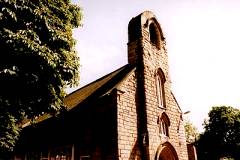 The hills were constantly echoing the fife and drums of marauding armies and, in more peaceful
times, the sound of the Northumbrian pipes.
The traditional musical instrument of North
Eastern England is differing from the Scottish war pipes in that they are blown
using bellows operated by the arm.
Some claim that Northumbrian pipes are best heard indoors,
while the Scottish pipes are heard best outdoors -
preferably from a distance of twenty miles away!
The hills were constantly echoing the fife and drums of marauding armies and, in more peaceful
times, the sound of the Northumbrian pipes.
The traditional musical instrument of North
Eastern England is differing from the Scottish war pipes in that they are blown
using bellows operated by the arm.
Some claim that Northumbrian pipes are best heard indoors,
while the Scottish pipes are heard best outdoors -
preferably from a distance of twenty miles away!
The Morpeth Chantry now
houses the
Northumbrian Bagpipe Museum,
displaying a collection of Northumbrian Small and Long Pipes, plus a small
stock of pipes - literally - from India to Inverness.
The museum is furnished with a cordless headphone sound system,
which links each display case with appropriate pipe music.
Finally, the pipes come alive regularly since the
Northumbrian Pipers' Society
meets at the museum.
The very next morning saw me crossing the Scottish border, in my bags
Brian McNeill's new novel
To Answer the Peacock.
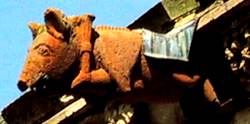 With it's own parliament, there's a buzz of enthusiasm now.
Simon Thoumire
wrote Music for a New Scottish Parliament, and
Sheena Wellington
performed the classic
A Man's a Man
for the opening ceremony.
Will there be a new awareness and promotion of Scottish music now?
With it's own parliament, there's a buzz of enthusiasm now.
Simon Thoumire
wrote Music for a New Scottish Parliament, and
Sheena Wellington
performed the classic
A Man's a Man
for the opening ceremony.
Will there be a new awareness and promotion of Scottish music now?
In
Melrose Abbey
I spied the famous gargoyle modelled as a bagpipe-playing pig. A
board in the Great Hall of the ruined Tantallon Castle told me about the Scots:
"Musick they have, but not the harmony of the sphears, but loud terrene noises,
like the bellowing of beasts; the loud bagpipes is their chief delight."
But Scotland has more to offer than silent stones.
The Dunbar Traditional Music Festival turned out as a small community gathering.
Apart from some golfers, there seemed to be no foreigners in town.
I caught "Jenny's Chickens" in full flight, four young lads with
fiddles, guitar and bodhran, knocking down reels with breakneck speed
and a hearty rendering of Radiohead's
"Creep".
And it surely was fuckin' special.
The ballad session next afternoon was of the same eclectic taste.
We got Folk, Blues and Jazz, and the local poet recited some of his verses -
in broad Scots. Thus, I didn't get any word, but it's been mighty crack.
Some jokes were passing around:
"Was `Maid on the Shore' on the A-Side or on the B-Side?"
"Ah, I think it was on the C-Side ..."
Afterwards I was heading further North. I was trespassing Killiecranckie,
scene of a Jacobite battle in 1688.
I just heard the commemorating ballad the night before:
"Oh, fie, Mackay! Ye'd better kiss'd King Willie's loof,
Than come to Killiecranckie, O."
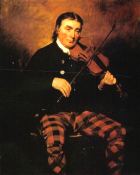 In nearby
Blair Castle,
the famous Niel Gow
was fiddler to four successive Dukes of Atholl.
It was the Scottish national bard
Robert Burns
who wrote:
"Nae fabled wizard's wand I trow /
Had e'er the magic art of Gow /
When in a wave he draws his bow /
Across his wondrous fiddle. /
In brisk strathspey or plaintive air /
What rival can wi' you compare /
O' wha could think a hank o' hair /
Could thus transform a fiddle!"
In nearby
Blair Castle,
the famous Niel Gow
was fiddler to four successive Dukes of Atholl.
It was the Scottish national bard
Robert Burns
who wrote:
"Nae fabled wizard's wand I trow /
Had e'er the magic art of Gow /
When in a wave he draws his bow /
Across his wondrous fiddle. /
In brisk strathspey or plaintive air /
What rival can wi' you compare /
O' wha could think a hank o' hair /
Could thus transform a fiddle!"
However, the "Home of Highland Music" is to be found
along the banks of the River Ness.
The Balnain House
in
Inverness
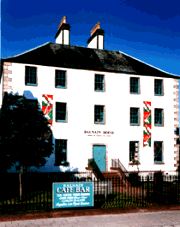 is closely assiociated with the history of
the Highlands. In 1746 it was used as hospital by the Hanoverian army after
the battle of
Culloden.
In the 19th century it housed a detachment of the Corps of Ordnance,
when the Highlands were being surveyed for the first
Ordnance Survey maps.
is closely assiociated with the history of
the Highlands. In 1746 it was used as hospital by the Hanoverian army after
the battle of
Culloden.
In the 19th century it housed a detachment of the Corps of Ordnance,
when the Highlands were being surveyed for the first
Ordnance Survey maps.
Now it offers concerts, ceilidhs, and classes.
You may explore Highland music in an audio/video exhibition
from its prehistoric origins to contemporary folk and rock.
(Unfortunatly, some listening stations were out of order when I put my hands on it.)
You may even try
bagpipe or
clarsach by yourself,
have a pint in the cellar bar,
or go shopping for both new and obscure CDs, books and tutors
(at least, if you can afford these incredible prices nowadays).
To raise funds, Eric Allan,
a director of Balnain as well as secretary of the
Inverness Fiddlers Society, offers a Tune for £50 service -
if you are still looking for a christmas present.
A donation to the exhibition came in the form of Niel Gow's chair.
The story is told about an evening's entertainment at Balnain:
"While outside the winds howled and the rain lashed against the window panes,
inside the Canada Room all was warmth and peace.
Iain Fraser
stood beside Niel Gow's chair and proceeded
to play Niel Gow's Lament for the Death of his Second Wife.
Its slow and melodic strains filtered through the entire house.
A woman in the third row sat bolt upright in her chair. Her gaze was fixed
on the fiddler. She reported later that she had seen a very elderly
gentleman appear at Iain's right shoulder. He was wearing ancient tweeds and
was particularly interested in Iain's fingerings on the fiddle.
He watched intently as the tune grew to its heartbreaking climax and, just
as suddenly as he had appeared - he disappeared again as the final strains
of the melody faded into the rousing applause of an unsuspecting audience."
Balnain House, where "Highland music lives ..."
Another ghostly experience
which awaits those who have a "wee dram too many".
The
Tam O' Shanter Experience near
Rabbie Burns' birthplace
in
Ayrshire.

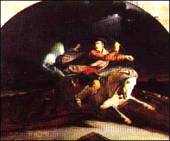 An audiovisual theatre in Alloway brings one of the oldest and best known tales
written by Burns back to life.
In the Auld Kirk,
Tam encountered - in the poet's own words -
"a dance of witches merrily footing it round their old sooty
blackguard master, who was keeping them all alive with the power of the
bagpipe. The ladies were all in their smocks, one of them, Nannie, having a
smock which was considerably too short to answer all the purpose of that piece
of dress ..."
When Tam is discovered and had to retreat, he is saved
only by the supreme efforts of his old mare Maggie at the
Brig o' Doon,
for Nannie grabs hold of Maggie's tail and pulls it off.
An audiovisual theatre in Alloway brings one of the oldest and best known tales
written by Burns back to life.
In the Auld Kirk,
Tam encountered - in the poet's own words -
"a dance of witches merrily footing it round their old sooty
blackguard master, who was keeping them all alive with the power of the
bagpipe. The ladies were all in their smocks, one of them, Nannie, having a
smock which was considerably too short to answer all the purpose of that piece
of dress ..."
When Tam is discovered and had to retreat, he is saved
only by the supreme efforts of his old mare Maggie at the
Brig o' Doon,
for Nannie grabs hold of Maggie's tail and pulls it off.
In fact, Scotland was the European country which had burnt the highest
proportion of its female population as witches. But that's a different story.
Let me tell you that I love you
And I think about you all the time
Caledonia, you're calling me
And now I'm going home
(Dougie MacLean)
- Morpeth Chantry Bagpipe Museum, Bridge Street, Morpeth, Northumberland NE61 1PD.
Tel: +44 (0)1670 519466. http://www.castlemorpeth.gov.uk/html/morpeth_bagpipe_museum.html.
Open Mon-Sat 10am-5pm, Summer Sundays and Bank Holidays 1pm-5pm.
- Balnain House, 40 Huntly Street, Inverness, Scotland IV3 5HR.
Tel: +44 (0)1463 715757, Fax: +44 (0)1463 713611.
http://www.balnain.com,
E music@balnain.com. Open Mon-Sat 10am-5pm, Cellar Bar Mon-Fri & Sun 5pm-11.30pm (10am-11.30pm on Saturdays).
CD: "Balnain - 20 Favourite tracks from the Balnain Exhibition"
- The Tam O' Shanter Experience & Visitor Centre, ...
Tel: +44 (0)1292 318086, Fax: +44 (0)1292 318094
http://www.robertburns.org/heritagepark,
E heritage.park@robertburns.org.
Open ...
|
Back to the content of FolkWorld
Articles, Live Reviews & Columns
To the content of FolkWorld
online magazine Nr. 17
© The Mollis - Editors
of FolkWorld; Published 12/2000
All material published in FolkWorld is © The Author via FolkWorld. Storage for private use is allowed and welcome. Reviews and extracts of up to 200 words may be freely quoted and reproduced, if source and author are acknowledged. For any other reproduction please ask the Editors for permission.
FolkWorld - Home of European Music

Layout & Idea of FolkWorld © The Mollis - Editors of FolkWorld
 The hills were constantly echoing the fife and drums of marauding armies and, in more peaceful
times, the sound of the Northumbrian pipes.
The traditional musical instrument of North
Eastern England is differing from the Scottish war pipes in that they are blown
using bellows operated by the arm.
Some claim that Northumbrian pipes are best heard indoors,
while the Scottish pipes are heard best outdoors -
preferably from a distance of twenty miles away!
The hills were constantly echoing the fife and drums of marauding armies and, in more peaceful
times, the sound of the Northumbrian pipes.
The traditional musical instrument of North
Eastern England is differing from the Scottish war pipes in that they are blown
using bellows operated by the arm.
Some claim that Northumbrian pipes are best heard indoors,
while the Scottish pipes are heard best outdoors -
preferably from a distance of twenty miles away!
 With it's own parliament, there's a buzz of enthusiasm now.
With it's own parliament, there's a buzz of enthusiasm now.
 In nearby
In nearby
 is closely assiociated with the history of
the Highlands. In 1746 it was used as hospital by the Hanoverian army after
the battle of
is closely assiociated with the history of
the Highlands. In 1746 it was used as hospital by the Hanoverian army after
the battle of

 An audiovisual theatre in Alloway brings one of the oldest and best known
An audiovisual theatre in Alloway brings one of the oldest and best known 